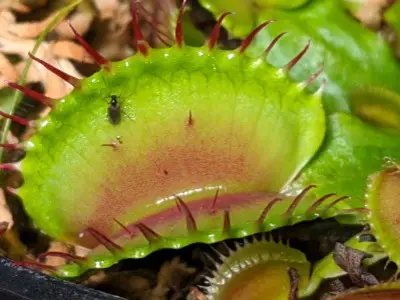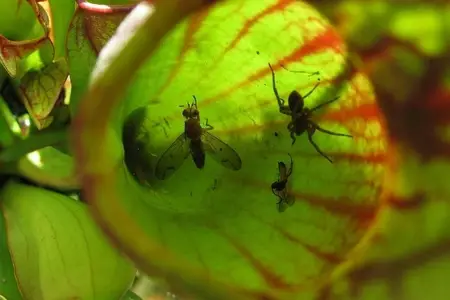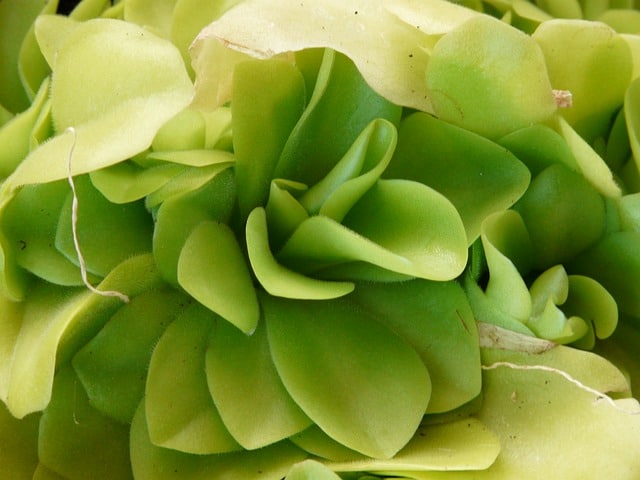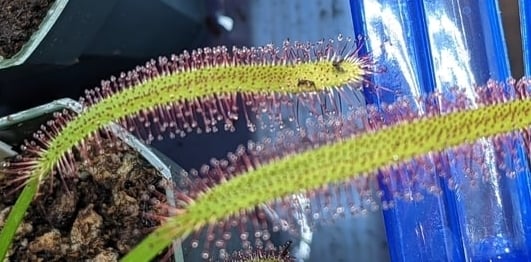Venus fly traps are known for their predatory nature, but are they good at attracting insects?
Venus fly traps attract flies and insects with sweet nectar and bright colors. However, they are not as powerful to bring insects to your home due. Instead, Venus fly traps will capture bugs wandering nearby.
Venus fly traps can work for pest control, and other carnivorous plants can be even better. I have owned Venus flytraps for many years and will review all the details in this article, starting with the basics.
Will Venus Fly Traps Attract Bugs to Your Home?
New Venus fly traps and carnivorous plant owners are generally concerned about these plants bringing pests to their homes.
In this section, you will learn why you do not have anything to worry about.
Venus fly traps attract bugs; they secrete sweet nectar and exhibit bright colors which mimic flowers. However, if you compare a Venus fly trap with maybe a rotten fruit left on a countertop, the fruit or open trash bag will undoubtedly attract more pests.
Venus fly traps will attract bugs similarly to a flower of about the same size, and venus fly traps are not large plants. They usually with traps of about 1 inch when they reach maturity.
Do not worry about a Venus fly trap bringing pests to your home. I had Venus fly traps for over five years and never encountered those problems.
Venus fly traps are good for pest control, capturing the occasional bug at home. They can capture one bug in each trap every 2-3 weeks.

How Venus Fly Traps Attract Flies and Other Insects
Venus fly traps attract flies and other bugs by producing sweet nectar inside their traps. Also, the bright colors of the plant mimic flowers.
The scent from Venus fly traps is very mild. Most humans cannot sense it at all- I have tried with no luck 😉
Insects nearby sense the sweet nectar and approach the trap to consume it. Once inside the trap, the Venus fly trap captures the insect as soon as they come in contact with its trigger mechanism.
Not all insects become prey of Venus fly traps, but some do. In the next section, we will explore how effective they are for pest control.
Venus Fly Trap Efficacy for Pest Control
Venus flytraps can capture bugs and reduce the bug population at home, but they are limited to consuming 5-10 bugs a month.
The plant’s size restricts them from capturing large bugs. Also, they can only capture a handful of bugs at a time and take weeks to consume them.
Venus fly traps only have three to seven leaves at a time. Each leaf has a trap that can capture an insect.
The number of leaves in a Venus fly trap limits the plant’s capabilities of capturing pests. Once a trap captures a bug, it digests it. The trap remains closed, unable to capture more insects for weeks until it reopens.
Even though a Venus fly trap won’t offer a pest control solution, it can still catch the occasional bug in your home. These are some examples of insects that become prey of Venus fly traps:
- Flies
- Fruit flies
- Gnats
- Ants
- Mosquitoes
- Spiders
Other pests, like cockroaches, are usually too big for a Venus fly trap to capture.
Besides venus fly traps, other carnivorous plants, such as Pitcher plants, are more effective bug controllers:
Some people employ carnivorous plants as bug controllers. Carnivorous plants can solve specific pest control scenarios, but different predatory plant species provide other benefits.
The Best Carnivorous Plants for Pest Control
The three most effective carnivorous plants for pest control are
- Pitcher Plants
- Sundews
- Butterworts
Here is an overview of each:
Pitcher Plants: These plants characterize by pitcher-like structures that attract bugs. Sweet scents lure bugs. If the victim slips inside the trap, slippery surfaces prevent the bug from escaping.
Pitcher plants can capture dozens of bugs at a time in each pitcher, and they have multiple pitchers ready to capture pests.

Butterworts: Butterworts or Mexican butterworts have sticky leaves with strong adhesives for insects. As insects walk through the leaves or land in one, they get stuck. When bugs attempt to fight their way out of the adhesive surface, they get stuck more and more.
All the leaves within the plant are capable of capturing and digesting prey. The only factor that limits how many bugs get stuck to the plant is the plant’s size.
Butterworts are great for controlling gnats, fruit flies, ants, and other smaller bugs.

Sundews: These plants also employ their adhesive leaves to capture bugs.
Bugs that get stuck to the leaves of the plant end up becoming food. Mature Sundews can capture more prey and larger bugs due to their size.

This was a general overview, but if you are serious about using carnivorous plants as pest control, read this article.
Where to Get a Venus Fly Trap
The five most common places where you can buy carnivorous plants, and Venus flytraps specifically, are specialized online shops, brick-and-mortar stores, local shops, and Amazon and Etsy.
Walmart, Trader Joe’s, Kroger, Home Depot, and several big box stores will seasonally carry Venus fly traps. They usually sell for 5 to 10 dollars. Those Venus fly traps are good, but they are generally straightforward. They won’t grow up to be those large and beautiful specimens you see in science books.
Online shops specializing in carnivorous plants offer beautiful Venus fly trap specimens and different varieties. They usually offer different types of Venus fly traps: some with larger traps, brighter colors, or even all-red Venus fly traps.
Here are a few good options to shop for Venus flytraps:
- predatoryplants.com
- carnivorousplantnursery.com
- californiacarnivores.com
- petflytrap.com
- flytrapcare.com/store/
The price of Venus fly traps varies depending on the store; however, it is usually around the same ballpark.
Standard Venus fly traps cost $5 to 10 dollars in most shops. Depending on the plant’s uniqueness, some varieties of fly traps can be pricier, usually between $10-25. The cost also varies if the plants are sold bare-root vs. potted.
Check out the Venus fly trap shopping guide for more tips.
Venus Fly Trap Care 101
Here is a brief overview of Venus fly trap care:
- Light: Venus flytraps need exposure to plenty of light. Optimally they should receive 12 hours of sunlight, and the minimum is 6 hours of light. The light source might be natural light or artificial lighting.
- Watering: Venus flytraps must be watered only with rainwater, distilled water, and reverse osmosis water. Tap water and bottled water kill carnivorous plants. Also, the soil of the plant must always remain moist.
- Soil: Employ nutrient-free soil for carnivorous plants. Never employ enriched soil full of fertilizers. This article covers many soil options for Venus flytraps.
- Feeding: Venus flytraps do not need to capture insects to survive, but they benefit from them greatly.
- Suitable pots: Do not place Venus flytraps in enclosed containers. Venus flytraps prefer standard plant pots with drainage halls. Depending on the plant’s size, choose a plastic or glazed ceramic container about 2-6 inches in diameter. Also, preferably employ a tall container.
- Repotting: repot the plant once a year to avoid soil compression, fungus, and mold.
- Trimming: When leaves in a Venus flytrap dry up, they turn black. Remove them once they dry out completely.
- Fertilizers: Do not fertilize Venus flytraps. The chemicals in the fertilizers can hurt the plant.
- Temperature: Keep Venus flytraps in temperatures within this range: 32 F – 95 F (0 C – 35 C). Do not burn them in the summer, and do not let them freeze solid in the winter.
- Humidity: Venus flytraps prefer humid climates but can adapt to dry environments.
- Stress: Do not play with the traps of your plant; it causes stress for the plant.
- Dormancy: Venus flytraps must undergo a dormancy period of 2-3 months during the winter. Ensure your plant will experience this yearly resting period by placing them in a cold location.
For a complete guide to Venus fly trap care that goes from beginners to advance step by step, read this other one of my articles: Ultimate Care Gude: Venus Fly Traps.

